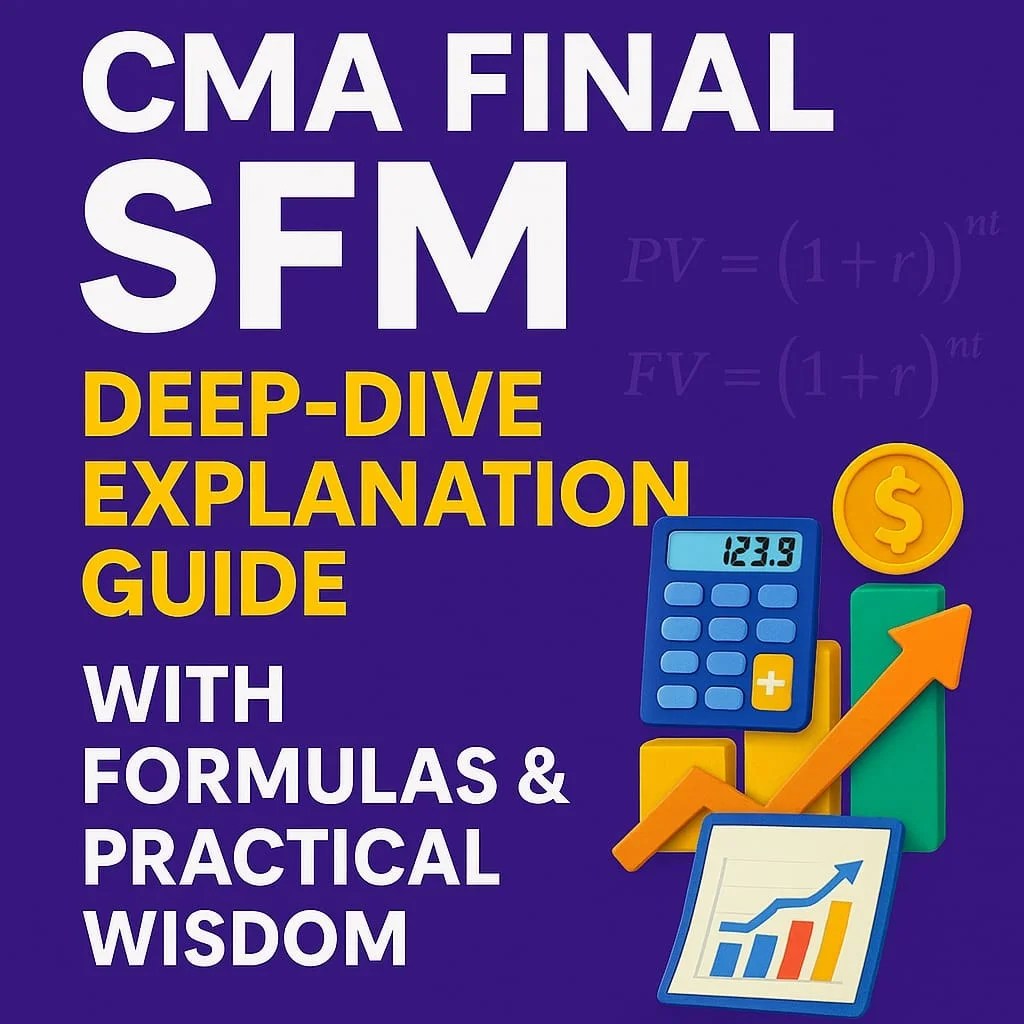This post has already been read 106 times!

CMA Final SFM — Deep Explanation Guide
with Key Formulas & Practical Mastery
This enhanced guide isn’t just a formula sheet—it’s designed to give you conceptual depth, practical context, and an intuitive understanding for every single SFM topic asked in the CMA Final 2025 exam. No rote learning here: the *why* and *how* of every formula is explained, with real-life flavor and application tips throughout.
Table of Contents
- A. Investment Decisions & Project Appraisal
- B. Security Analysis & Portfolio Management
- C. Financial Risk Management
- D. International Financial Management
- E. Mergers, Acquisitions & Corporate Valuation
- F. Derivatives (Futures, Options, Swaps)
- G. Mutual Funds & Performance Measurement
- H. Digital Finance Overview
A. Investment Decisions & Project Appraisal
1. Net Present Value (NPV)
NPV = Σ [CFt / (1 + r)^t ] – Initial Investment
- CFt = expected net cash flow in year t (inflows – outflows that year).
- r = required rate of return (discount rate, typically company’s WACC).
- t = respective year.
Pharma firm is considering a new line: Cost today = ₹40,00,000. It’s estimated to generate net cash flows of ₹13,00,000 in years 1 and 2, ₹17,00,000 in year 3, ₹20,00,000 in year 4. Cost of capital is 12%.
PV factors:
Year 1: 0.893, Year 2: 0.797, Year 3: 0.712, Year 4: 0.636
PV(Year 1) = ₹13,00,000×0.893 = ₹11,60,900
PV(Year 2) = ₹13,00,000×0.797 = ₹10,36,100
PV(Year 3) = ₹17,00,000×0.712 = ₹12,10,400
PV(Year 4) = ₹20,00,000×0.636 = ₹12,72,000
Sum PV inflows = ₹46,79,400
NPV = 46,79,400 – 40,00,000 = ₹6,79,400
Decision: Since NPV > 0, the project should be accepted; it creates value for the company.
2. Internal Rate of Return (IRR)
Set NPV = 0 and solve for r in: Σ [CFt / (1 + r)^t] = Initial Outlay
Try r = 12%:
PV(40,000, 4 years, 12%) = 40,000 × PVAF(12%,4) = 40,000 × 3.037 = ₹1,21,480 (NPV slightly positive)
Try r = 14%:
PVAF(14%,4) = 2.914; PV = ₹1,16,560 (NPV negative)
IRR = 12% + [ (1,480) / (1,480+3440) ] ×(14-12) ≈ 12.6%
3. Modified Internal Rate of Return (MIRR)
MIRR = (FV of all +ve CFs / PV of all -ve CFs )^(1/n) – 1
Year 1: 15,000 | Year 2: 18,000 | Year 3: 32,000
Assume both investing (discount) and reinvestment rate is 10%.
PV (-ve CF) = 50,000
FV(+ve CFs at yr 3): 15,000×1.21 + 18,000×1.10 + 32,000 = 18,150 + 19,800 + 32,000 = ₹69,950
MIRR = (69,950/50,000)^(1/3) –1 ≈ 12.4%
4. Payback & Discounted Payback Period
Payback = years before recovery + (amount to recover/cash flow in year of recovery)
need ₹16,000 more. Third year earns ₹22,000.
Payback = 2 + (16,000/22,000) ≈ 2.73 years.
B. Security Analysis & Portfolio Management
1. Bond Valuation
Price = Σ (Coupon / (1 + YTM)^t ) + Face Value/(1 + YTM)^n
PV coupons: 80/1.09 = 73.4; 80/1.1881 = 67.3; 80/1.2950 = 61.8
PV FV: 1000/1.295 = 772.8
Total value = 73.4 + 67.3 + 61.8 + 772.8 = ₹975.3
2. Yield to Maturity (YTM) and Current Yield
YTM ≈ [Coupon + (FV-Price)/n ] / [(FV+Price)/2]
YTM = [80 + (1000–975)/3] / [(1000+975)/2]
= (80 + 8.33) / 987.5 = 0.089 or 8.9%
3. Duration and Modified Duration
Duration = Σ [ t × PV(CFt) ] / Price
4. Dividend Discount Model (DDM)
Value = D1 / (Ke − g)
5. CAPM and Beta
Ke = Rf + β (Rm − Rf)
Ke = 6 + 1.25×(12–6) = 6 + 7.5 = 13.5%
6. Portfolio Expected Return and Variance
Rp = w1 R1 + w2 R2
σp² = w1²σ1² + w2²σ2² + 2w1w2ρσ1σ2
C. Financial Risk Management
1. Value at Risk (VaR)
VaR = Z × σ × √t × Portfolio Value
VaR = 2.33×0.022×1,00,00,000 = ₹5,12,600
This tells you: “There is only a 1% chance you will lose more than this in one day.”
D. International Financial Management
1. Forward Exchange Rate
F = S × (1 + id)/(1 + if)
F = 82.5 × 1.06 / 1.02 = 85.78
E. Mergers, Acquisitions & Corporate Valuation
1. DCF Valuation of Company
Firm Value = Σ [FCFt / (1+WACC)^t]
2. Post Merger EPS
EPS = Combined PAT / Total Shares after Merger
F. Derivatives
1. Futures Cost-of-Carry
F = S × e^(r – y) T
2. Black-Scholes Formula (Call Option)
C = S N(d1) – K e^(–rT) N(d2) d1 = [ln(S/K) + (r + σ²/2)T ]/ σ√T d2 = d1 – σ√T
3. Swap Valuation
Fixed payment = Notional × Rate × (Days/360)
G. Mutual Funds & Performance
1. NAV
NAV = (Assets – Liabilities)/Units
2. Sharpe, Treynor, Jensen’s Alpha
Assess MF performance after adjusting for market or absolute risk.
